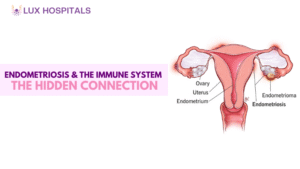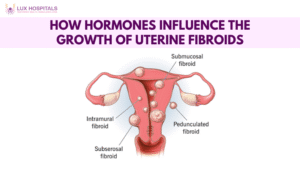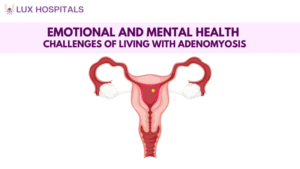Common Uterine Fibroid Symptoms

Uterine fibroids are non-cancerous growths that develop in or on a woman’s uterus. Although not all fibroids are problematic, many women can endure noticeable side effects that can make their daily lives more difficult. Early identification and appropriate treatment of uterine fibroids depend on understanding their symptoms.
You can use this guide to recognize the warning signals and determine when to consult a physician. Although they can occur in women of any age, these growths are most prevalent in fertile women.
What Are Uterine Fibroids?
Uterine fibroids, or leiomyomas, are benign tumors of muscle and fibrous tissue. They vary in size, from tiny seedlings undetectable by the human eye to large masses that can distort the uterus. While the cause isn’t fully understood, hormonal and hereditary factors are thought to be involved.
Many women don’t realize they have fibroids until symptoms appear or they’re discovered during a routine pelvic exam.
Symptoms of Uterine Fibroids
1. Heavy or Prolonged Menstrual Bleeding
One of the hallmark uterine fibroid symptoms is heavy periods. You might soak through sanitary products quickly, or your period might last more than a week. This excessive bleeding can lead to anemia, fatigue, and general weakness. Many women report passing blood clots during their cycle. This symptom can be alarming and may interfere with daily responsibilities.
2. Pelvic Pain and Pressure
Persistent pressure or pain in the lower abdomen is a common complaint. Large fibroids can press against surrounding organs, causing a dull ache or sharp discomfort. This might also be a clue if you feel bloated or full without eating much. This sensation can mimic other conditions like ovarian cysts or endometriosis. Long-standing pelvic pain shouldn’t be ignored, as it’s one of the defining uterine fibroid symptoms.
3. Frequent Urination
Fibroids pressing on the bladder can cause you to urinate more often, and you might even feel like you can’t empty your bladder. This is a more disruptive uterine fibroid symptom, especially at night. Some women experience urgency and can’t hold their urine for long. Sleep disruption due to nighttime urination affects energy and mood. A weak urine stream or dribbling may also occur.
4. Difficulty Emptying the Bladder
In contrast to frequent urination, some women experience trouble urinating at all. This happens when fibroids block the normal urine flow, creating a backup or weak stream. If urination becomes painful or difficult, medical help is needed. This less common but serious uterine fibroid symptom should not be ignored.
5. Constipation
Fibroids near the rectum can interfere with bowel movements, leading to chronic constipation. This symptom can often be mistaken for dietary issues, but should be investigated if persistent. The pressure can cause discomfort when trying to pass stool. Straining can worsen hemorrhoids or lead to anal fissures. You may feel like you haven’t completely emptied your bowels. Constipation is a hidden but real uterine fibroid symptom that affects daily life.
6. Pain During Intercourse
Pain during sex (dyspareunia) is a lesser-known uterine fibroid symptom but can significantly affect intimacy and relationships. Fibroids near the cervix or lower uterus may be the cause of minor discomfort to severe cramps; the pain might vary. Women often feel anxious about intimacy due to this symptom. Some positions may hurt more than others.
7. Lower Back Pain
Fibroids at the back of the uterus can press against spinal nerves, leading to back pain. This discomfort might radiate down your legs, similar to sciatic nerve pain. Sitting or standing for a long time can worsen the pain. Anti-inflammatory medications may provide temporary relief. If lower back pain persists, it could be among the lesser-known uterine fibroid symptoms.
8. Abdominal Swelling
Large fibroids could be responsible if your belly suddenly feels bigger or looks bloated without weight gain. In extreme cases, women may appear several months pregnant. In some cases, the swelling can be firm to the touch. Consistent abdominal changes should be discussed with a healthcare provider to rule out uterine fibroid symptoms.
9. Painful Periods
Beyond heavy bleeding, periods might also become more painful. Cramping intensifies as the uterus works harder to shed its lining and deal with fibroid presence. Persistent pain may be one of the more frustrating uterine fibroids symptoms. The cramping can disrupt sleep and daily function.
10. Leg Pain
Large fibroids can press on pelvic nerves and blood vessels, causing leg discomfort. This symptom is rarer but worth noting, especially if other signs are present. Leg symptoms often accompany back or pelvic pain. Although not common, it’s a valid uterine fibroid symptom in more advanced cases. The pressure can cause numbness, tingling, or aching. Walking or standing may become painful over time. Some women feel this pain deep within the muscles.
11. Fatigue and Weakness
Chronic blood loss from heavy periods leads to iron-deficiency anemia. This results in fatigue, dizziness, and weakness, essential indicators of severe uterine fibroid symptoms. Iron supplements or diet changes may help, but treating fibroids is the root solution. Unexplained fatigue is often underestimated but should not be ignored.
12. Complications with Fertility or Pregnancy
Fibroids can raise the chance of miscarriage or obstruct the implantation of a fertilized egg. They may also cause complications during labor and delivery. Some women have difficulty conceiving due to fibroid blockage. During pregnancy, fibroids may grow and cause pain or premature labor. Proper monitoring throughout pregnancy is necessary. For people attempting to conceive, these reproductive problems are among the most worrisome uterine fibroids.
Conclusion
Understanding and recognizing uterine fibroid symptoms is crucial for taking control of your reproductive health. While the condition is chronic, it’s manageable with the proper care. If you’re experiencing any of the symptoms listed above, don’t hesitate to consult a healthcare provider. Treatment and early detection can significantly enhance the quality of life and prevent further complications. Prompt action can avert more significant issues and improve overall well-being.
Frequently Asked Questions
The earliest symptoms of uterine fibroids often include prolonged periods, heavy menstrual bleeding, and pelvic discomfort. These symptoms might feel like a normal variation of your cycle, but persistent changes in flow or pain levels should raise concern. An early diagnosis can prevent more severe complications later on.
A combination of symptoms and imaging tests usually leads to a diagnosis. If you notice heavy periods, pelvic pressure, or frequent urination, speak with a gynecologist. An ultrasound or MRI can confirm fibroids’ presence, size, and location.
Fibroid pain can range from mild cramping to sharp, stabbing sensations. It may feel like intense menstrual cramps or pressure in the pelvis. The pain sometimes radiates to the lower back or legs, especially if fibroids press on nearby nerves.
Small fibroids can sometimes shrink or disappear, especially after menopause, when hormone levels drop. However, most require monitoring and treatment to manage symptoms. Depending on severity, lifestyle changes, medications, or surgical options may be necessary.
The vast majority of fibroids are benign. Rarely, a fibroid may be cancerous, but this occurs in less than 1% of cases. If fibroids proliferate or cause unusual symptoms, doctors may recommend further testing to rule out malignancy.




















